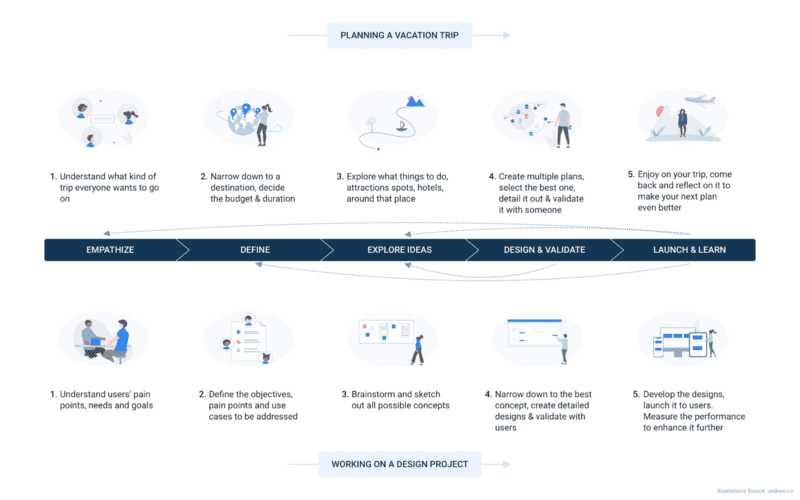Where are you headed this winter?
It’s that time of year when many of you would have already started planning your next vacation trip (or even already planned one!). After being confined to your home for the past couple of years amidst the pandemic, making plans can seem exciting and almost fun!
To us, planning is critical to success. You follow a sequence of steps to make sure you covered all the important parts of whatever you’re doing, and that ensures the best outcome. Whether it’s a trip or a new product feature. The Design Team at Gainsight also follows a similar process at work. Isn’t that interesting! Let’s take a look at how it goes!

Whether you know it or not, you are always following a certain thinking process – Empathize → Define → Ideate → Design → Launch & Learn, whenever you plan for trips, while buying a car, and even at work. This is what you call the design thinking process. It helps define how things are to be done and helps focus to make them better and get successful outcomes.
Design at Gainsight
Gainsight Design strives to create innovative and intuitive meaningful experiences for our users, enabling them to achieve their goals easily and efficiently. We believe in keeping our users at the core and following an agile design process to build our products. When it comes to the design process, there’s no one-size-fits-all. Keeping in mind the complex nature of our products and the varied needs of our users, we came up with a design process that is tailored-fit to suit our products.

Let’s jump into the key principles of our process!

1. Empathizing with Our Users
Designing for what users actually need goes a long way in creating great value and intuitive experiences for our users. We regularly empathize with our users to understand their goals, needs, pain points and behaviors through different mediums like user interviews, customer calls, focus group discussions, Gainsight community, etc. However, there are always some constraints, like tight timelines that we need to work in and conducting full-fledged research may not be possible. To tackle these challenges we started involving our Customer Success Managers (CSMs), Sales and Support Teams as a proxy for our users to uncover the user’s goals and pain. This proved to be a super effective and quick method during tight project timelines.
Gainsight PX also empowers us to learn what exactly our users are doing in our product, where they get stuck and helps us make design decisions.
2. Exploring Concepts to Drive Innovation
It’s a natural tendency for humans to consider the first idea they get as their best idea, and directly jump to build the solution around it. However, this limits our creativity and innovation. To avoid such scenarios we introduced a Concept Exploration phase, where all that one has to do is brainstorm and quickly sketch out all possible concepts with pen and paper. This helps us to get out all top-of-mind ideas and then think 10X to stretch ourselves to come up with out-of-the-box innovative ideas. Playing with ideas to merge or combine them enables us to come up with even better ones and then converge on one concept after validating it with stakeholders and users.
3. Designing Along with a Co-Pilot
We have all been there – getting stuck on something in your project or getting attached to a particular solution, and then just waiting for some cool ideas to swoop in and get you going again. Here’s where a co-pilot comes to our rescue. A co-pilot is a designer teammate who brings in a different perspective, gives feedback on our designs and helps us explore further design directions. Having this second opinion brings out new ideas that one may have not thought of before.
4. Validating before Launch
We keep users at the center of every stage of the project. Getting feedback early on from users on the designs before launch is valuable in helping us know if we have designed the right experience our users actually need. Usability testing sessions with users help us validate our hypothesis, identify design flaws, usability issues and fix them early on.
For projects with time constraints, conducting usability testing sessions with users can get tricky. It’s far better to run some testing than no testing at all! We had to come up with something that was quick and effective. Here again, we turned to our customer-facing teams – CSMs, Sales, and Support teams, acting as a proxy for our users to test out our designs and give feedback. Customer-facing teams can provide you deep insights about your user behaviors and their needs.
5. Measuring Designs to Elevate the Experience Even Further
Even after the implementation and launch of our designs, our job is still not done! We continue to measure our designs and track their performance in the form of UX metrics through Gainsight PX, customer calls, customer feedback, surveys, and user testing. Measuring designs is essential in providing a sustainable product experience for your users.
Even you can use this process
Everyone, irrespective of being a product designer, can apply the principles of our design process at their work or even in your everyday life, just like we saw above while planning a trip. Empathize → Define → Ideate → Prototype → Validate. Depending on the context, one can customize the thinking process to be tailored-fit for the task and keep evolving the process as the task evolves. Following such a process will not only make the things or tasks ordered but will help achieve successful and consistent results.
Let us know how you plan to use this process in your work or everyday life!
